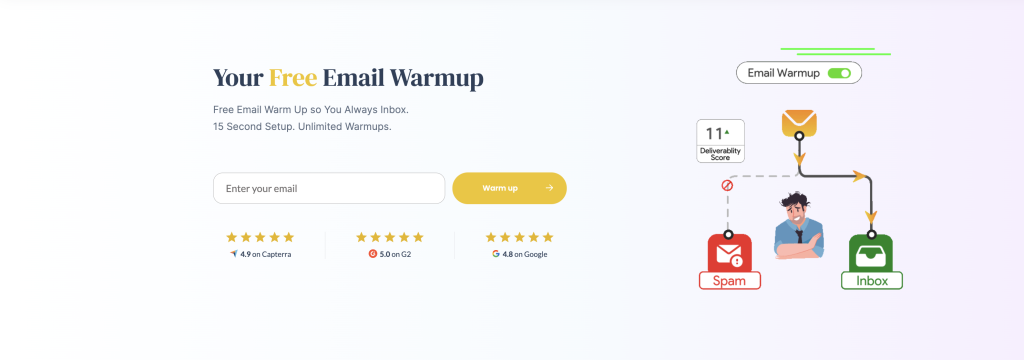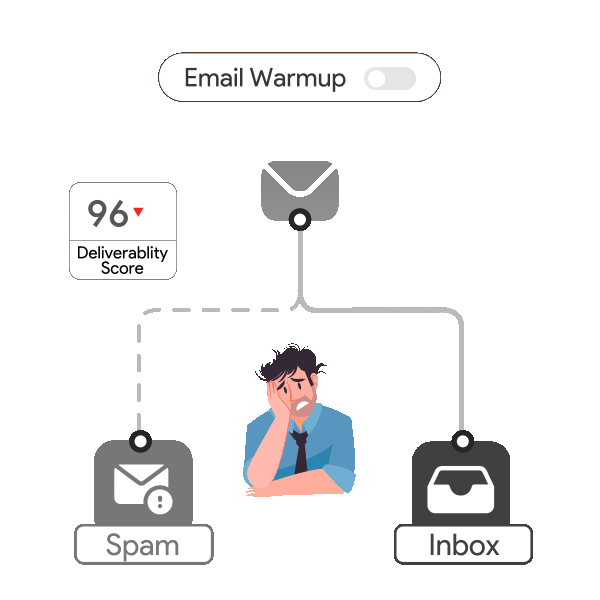Imagine your emails reaching more inboxes and generating higher response rates – all from a simple Domain Warm Up for Emails.
In a fast-paced email marketing world of 361 billion daily emails, success means reaching the right inboxes. Unlock the potential of your email campaigns to optimizing outreach tactics through warming up your email domain.
Let us delve into the art of warming up your domain, empowering you to elevate your outreach strategies and reap the rewards of a thriving email campaign.
What is a Domain Warm Up?

Domain warm up is the systematic process of gradually increasing email volume week by week on a new domain to build a positive sending reputation with mailbox providers while targeting engaged users.
Email providers use automated systems to find suspicious emails. Sender reputation is important – it shows how trustworthy an email sender is. New or low-reputation emails may get marked as spam. That’s where domain warm-up comes in.
By gradually sending more emails, providers get used to the sender, reducing the chance of emails being rejected or marked as spam.
Do I Need to Warm Up My Email Domain?

Wondering if you should warm up your email domain? The short answer: yes, it’s crucial. Email domain warming is essential for establishing a positive reputation with email providers, which directly impacts your email deliverability.
It boils down to two key points.
- Firstly, if your emails lack engagement, they’re more likely to end up in spam folders.
- Secondly, being marked as spam harms your reputation and deliverability even more.
Ultimately, if your emails go unopened, unanswered, or are reported as spam, it suggests they’re not resonating with anyone. Without proper warming, your emails might end up in spam folders or get blocked altogether.
So, whether you’re a new sender or making significant changes to your email practices, warming up your domain is a must for effective email marketing.
5 Reasons to Why Email Domain Warm is Crucial

A warmed-up domain boosts your sender reputation, facilitating inbox placement in recipients’ main inboxes. Compelling reasons to why email domain warm-up include:
1. Cultivating Favorable Domain Reputation
Establishing a positive perception of your domain among email providers, enhancing trust and credibility.
Google Postmaster Tools confirms that reputable domains face fewer spam and filtering issues.
2. Evading Spam Folders
Ensuring that your emails reach recipients’ inboxes instead of being diverted to spam folders, maximizing visibility and engagement opportunities.
3. Enhancing Email Deliverability Rates
Improving the likelihood of your emails successfully reaching their intended recipients, facilitating effective communication and interaction.
4. Maximizing Audience Engagement
Increasing the level of involvement and interaction with your email content among recipients, fostering stronger connections and responses.
5. Facilitating A/B Testing
Providing the flexibility to conduct A/B testing within your email campaigns, enabling optimization and refinement for better performance and results.
How To Warm Up Email Domain?

The question “What is the best way to warm up email domain?” is frequently asked but remains unclear. Engaging in domain warm-up entails numerous activities aimed at gradually but steadily enhancing your domain reputation over time.
If you aim for optimal email deliverability and results. Consider these key practices for effectively warming up your email domains:
1. Understand your sending boundaries

Consider upgrading to an Email Service Provider (ESP) that can handle high email volumes if you’re sending a lot of emails. Avoid using free accounts like Gmail or Outlook for mass email campaigns because they’re often misused for illegitimate purposes, which can affect deliverability.
Note: Many ESPs link sent emails to recipients, making BCC attempts ineffective.
2. Establish email authentication

Implementing email authentication shows ISPs your domain’s trustworthiness. It verifies emails swiftly, blocking hackers’ spoofing attempts. It also protects customers from spam. Authentication includes SPF, DKIM, and DMARC protocols for sender verification.
3. Enhance IP reputation

Maintaining a positive IP reputation is crucial for email delivery. A tarnished reputation can lead to blockages or spam folder placement, harming your domain reputation. ISPs prioritize user protection, so a poor IP reputation may hinder email delivery to subscribers.
4. Steer clear of spam-triggering terms

Spam filters target suspicious words, like “FREE” or “BUY NOW,” increasing the chance of spam folder placement. Avoid click-bait titles and deceptive claims to prevent misleading recipients.
Make sure to check email for spam triggers.
5. Craft compelling content

Compelling email content is key to avoiding emails going to spam and keeping reader engagement. Scammy content risks being ignored or marked as spam, hurting your domain reputation. Enhance content by personalizing messages, optimizing length, and ensuring readability.
6. Transition to a dedicated IP

Consider switching from a shared IP to a dedicated one for better reputation control. Shared IPs can be affected by others, risking your reputation. A dedicated IP ensures greater control over reputation and domain integrity.
7. Most Important: Leverage warm-up tools

While warming up an email domain is essential, it’s also time-intensive. Utilizing tools like Automated Email Warm-Up streamlines the process by managing engagements and gradually increasing email volume on your behalf.
Why stress over manual warmup when automation can handle it for you?
How long does it take to warm up domain?

Domain warm-up typically takes up to 4-8 weeks to fully warm your dedicated sending domain up to 3 months, during which you gradually increase sending volume and monitor metrics like open rates and spam complaints to build trust with ISPs and recipients.
However, the timeline can vary depending on your circumstances. Automated email warm-up setup, on the other hand, is a quick 15-second process.
Warm Up Inbox: The Solution for You

Elevate your email domain effortlessly with the best email warmup tools. Sending emails manually in small volumes with strategic spacing can be time-consuming, especially on larger platforms.
Automated Email Warm-Up tools follow a precise schedule, gradually increasing email volume to establish a positive reputation with ISPs.
By adopting automation, you not only save time but also improve the efficacy of your warm-up strategy, laying the groundwork for a successful email marketing campaign.
Why Automated Email Warm-Up?
Automated Email Warm-Up offers unparalleled benefits for your email marketing strategy. With unlimited warmups, it ensures consistent delivery to recipients’ primary inboxes. Its seamless background warmup feature enhances sender reputation without disrupting your inbox.
Setup is a breeze, taking just 15 to 30 seconds, saving you time and hassle. Plus, its AI-driven personalized approach impresses platforms like Google, ensuring your emails stand out without triggering spam filters.
Let’s bring it to a close!
As we reach the conclusion of this topic, you now understand the importance of warming up your email domain prior to outreach and how a warmed-up email domain leads to more successful leads. You were introduced to the best solution for warming up your email domain: Automated Email Warm-Up.
While manual warm-up processes are feasible, they can be time-consuming and require constant attention. On the other hand, automated solutions streamline the process, saving time and effort while ensuring consistent results.
Get ready for big and powerful connections by choosing the right partner for your email campaign! Spend your time on what you love, and Automated Email Warm-Up will handle the rest.
Keep warm and safe!
Leave a Reply